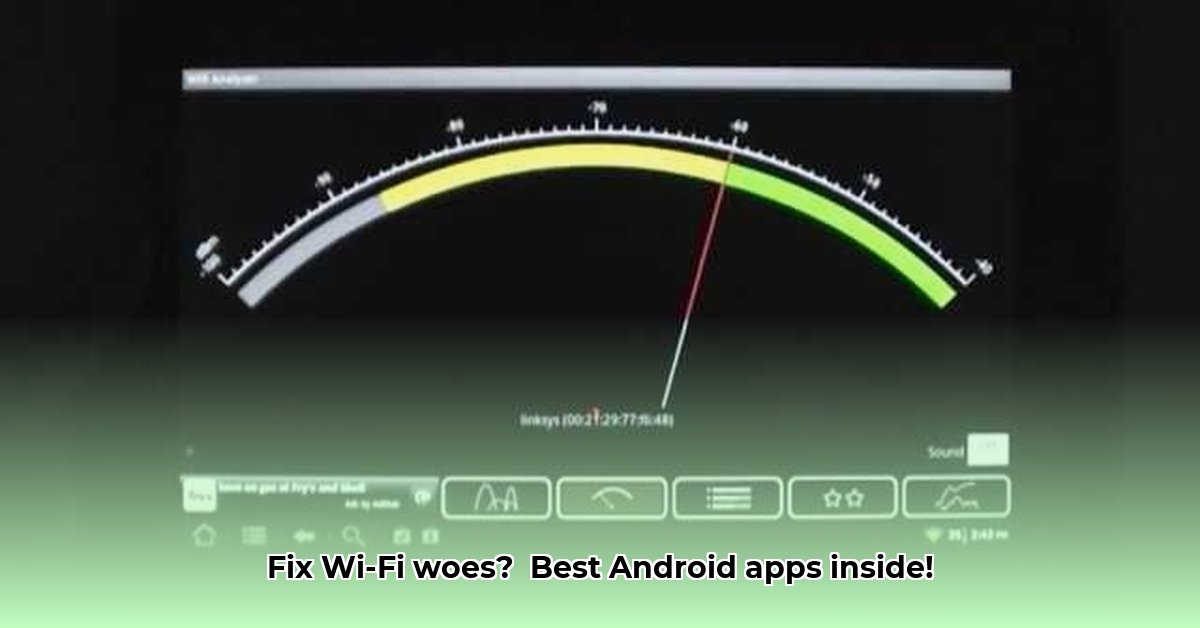
Is your Wi-Fi connection constantly frustrating you with slow speeds and dropped connections? Android Wi-Fi analyzer apps offer a powerful solution. These tools provide insights into your network's performance, helping you pinpoint and resolve common Wi-Fi issues. This guide will review several top apps and provide a step-by-step guide to troubleshooting your network.
Choosing the Right Wi-Fi Analyzer App
The Google Play Store offers a wide selection of Wi-Fi analyzer apps, ranging from simple, free utilities to sophisticated, paid professional tools. The best choice depends on your technical skills and needs.
Casual Users: If you only need occasional checks for basic issues like signal strength or speed, a free, user-friendly app will suffice. These generally display signal strength, speed test results, and a basic channel analysis.
Tech Enthusiasts/Professionals: For in-depth analysis, advanced features like heatmaps and detailed channel mapping, you'll need a more powerful (and likely paid) app. These tools provide more comprehensive data for resolving complex network problems.
Let's compare some popular options:
| App Name | Cost | Key Features | Pros | Cons |
|---|---|---|---|---|
| WiFi Analyzer | Free | Signal strength, channel analysis, basic speed tests | Simple interface, easy to use, generally reliable | Limited advanced features, might lack detailed reporting |
| NetSpot (Android) | Paid | Detailed site surveys, heatmaps, advanced channel analysis | Comprehensive data, professional-grade analysis capabilities | Steeper learning curve, significant cost |
| OpenSignal | Free | Signal strength, network coverage maps, data usage insights | Easy to use, provides broader network data including carrier info | Less technical detail, focuses on overall network performance |
| Network Analyzer Pro | Paid | Deep network diagnostics, extensive troubleshooting features | Powerful, in-depth analysis, often includes support | Complex interface, significant cost, may require technical knowledge |
Don't just take our word for it. Many apps have user reviews available online; carefully review these before downloading. Remember, a high rating doesn't automatically mean it's the best app for you.
Using Your Wi-Fi Analyzer App: A Step-by-Step Guide
Using a Wi-Fi analyzer is straightforward, though the exact steps vary slightly between apps. The general process is:
- Download and Install: Get your chosen app from the Google Play Store.
- Grant Permissions: The app requires access to your Wi-Fi information and, potentially, your location. Review the permissions carefully before granting access. Why is this important? This safeguard protects your privacy; unauthorized apps could potentially misuse your data.
- Perform a Network Scan: Most apps automatically scan your Wi-Fi network. Others require manual initiation. Have you ever wondered why scans sometimes take a while? This is because the app is carefully measuring and recording many data points.
- Analyze the Results: Examine key metrics like signal strength (dBm - higher is better, but remember it's a logarithmic scale), channel congestion (lower is better), and potential interference sources. Android's power-saving features can sometimes throttle Wi-Fi scans. We'll address this in the next section.
Troubleshooting: Let's address common Wi-Fi problems:
- Weak Signal Strength: A consistently low signal suggests your router might be too far, obstructed, or needs repositioning.
- Channel Congestion: A crowded channel slows speeds. Many analyzers suggest less-congested alternatives; switching channels is usually a quick fix.
- Identifying Interference: Appliances (microwaves, cordless phones) can interfere with Wi-Fi. Relocating these devices often solves the problem.
How to Bypass Android Wi-Fi Scan Throttling
Android's power-saving features sometimes throttle Wi-Fi scans, reducing the accuracy of analyzer apps. To improve accuracy (although this will increase battery drain):
- Enable Developer Options: Go to Settings > About Phone, tap the "Build number" repeatedly until Developer options appear.
- Access Developer Options: Find and tap Developer options.
- Locate Wi-Fi Scan Settings: Look for settings related to Wi-Fi scanning (the exact name varies).
- Disable Throttling: Enable the setting for unrestricted Wi-Fi scanning.
- Restart the App: Close and reopen the app for changes to take effect.
Remember: This increases battery consumption; use it only when needed for in-depth analysis.
Advanced Features and Deeper Troubleshooting
Advanced apps offer powerful features:
- Channel Mapping (Heatmaps): Visually represent Wi-Fi signal strength, identifying dead zones.
- Port Scanning: Tests network ports; use only on your own networks or with explicit permission. Unauthorized port scanning is illegal.
Remember: Always prioritize responsible use and respect the law.
Key Takeaways
- Android's power-saving features throttle Wi-Fi scans.
- Disabling throttling boosts accuracy but drains battery.
- App choice depends on your needs (casual vs. professional).
- Balance app capabilities and battery life.
This guide provides a solid foundation for using Android Wi-Fi analyzer apps. Further exploration and responsible use will help you optimize your Wi-Fi experience.
⭐⭐⭐⭐☆ (4.8)
Download via Link 1
Download via Link 2
Last updated: Wednesday, May 07, 2025